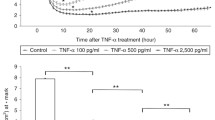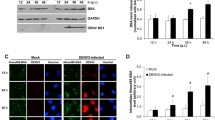Abstract
A growing body of evidence demonstrates that endothelial cells (ECs) play a prominent role in immune-enhanced pathology seen in dengue virus (DENV) infection that might contribute to vascular permeability and hemorrhagic manifestations in severe dengue cases. However, it remains a question of whether DENV infection of ECs directly causes permeability or if extra-endothelial factors such as immune cell activation or antibody-dependent enhancement (ADE) are required. In this chapter, we detail the measurement of the transendothelial electrical resistance (TEER), a quantitative technique to measure the integrity of tight junction dynamics in cell culture models of endothelial monolayers and show that DENV infection of ECs does not cause endothelial permeability in vitro.
Access this chapter
Tax calculation will be finalised at checkout
Purchases are for personal use only
Similar content being viewed by others
References
Aird WC (2004) Endothelium as an organ system. Crit Care Med 32(5 Suppl):S271–S279. https://doi.org/10.1097/01.ccm.0000129669.21649.40
Cines DB, Pollak ES, Buck CA et al (1998) Endothelial cells in physiology and in the pathophysiology of vascular disorders. Blood 91(10):3527–3561
Dvorak HF (2010) Vascular permeability to plasma, plasma proteins, and cells: an update. Curr Opin Hematol 17(3):225–229. https://doi.org/10.1097/MOH.0b013e3283386638
Valbuena G, Walker DH (2006) The endothelium as a target for infections. Annu Rev Pathol 1:171–198. https://doi.org/10.1146/annurev.pathol.1.110304.100031
Basu A, Chaturvedi UC (2008) Vascular endothelium: the battlefield of dengue viruses. FEMS Immunol Med Microbiol 53(3):287–299. https://doi.org/10.1111/j.1574-695X.2008.00420.x
Halstead SB (2007) Dengue. Lancet 370(9599):1644–1652. https://doi.org/10.1016/S0140-6736(07)61687-0
Pierson TC, Diamond MS (2020) The continued threat of emerging flaviviruses. Nat Microbiol 5(6):796–812. https://doi.org/10.1038/s41564-020-0714-0
Rey FA, Stiasny K, Vaney MC et al (2018) The bright and the dark side of human antibody responses to flaviviruses: lessons for vaccine design. EMBO Rep 19(2):206–224. https://doi.org/10.15252/embr.201745302
Katzelnick LC, Gresh L, Halloran ME et al (2017) Antibody-dependent enhancement of severe dengue disease in humans. Science 358(6365):929–932. https://doi.org/10.1126/science.aan6836
Beatty PR, Puerta-Guardo H, Killingbeck SS et al (2015) Dengue virus NS1 triggers endothelial permeability and vascular leak that is prevented by NS1 vaccination. Sci Transl Med 7(304):304ra141. https://doi.org/10.1126/scitranslmed.aaa3787
Puerta-Guardo H, Glasner DR, Harris E (2016) Dengue virus NS1 disrupts the endothelial glycocalyx, leading to hyperpermeability. PLoS Pathog 12(7):e1005738. https://doi.org/10.1371/journal.ppat.1005738
Balsitis SJ, Coloma J, Castro G et al (2009) Tropism of dengue virus in mice and humans defined by viral nonstructural protein 3-specific immunostaining. Am J Trop Med Hyg 80(3):416–424
Balsitis SJ, Williams KL, Lachica R et al (2010) Lethal antibody enhancement of dengue disease in mice is prevented by Fc modification. PLoS Pathog 6(2):e1000790. https://doi.org/10.1371/journal.ppat.1000790
Jessie K, Fong MY, Devi S et al (2004) Localization of dengue virus in naturally infected human tissues, by immunohistochemistry and in situ hybridization. J Infect Dis 189(8):1411–1418. https://doi.org/10.1086/383043
Dalrymple N, Mackow ER (2011) Productive dengue virus infection of human endothelial cells is directed by heparan sulfate-containing proteoglycan receptors. J Virol 85(18):9478–9485. https://doi.org/10.1128/JVI.05008-11
Dalrymple NA, Mackow ER (2012) Roles for endothelial cells in dengue virus infection. Adv Virol 2012:840654. https://doi.org/10.1155/2012/840654
Dalrymple NA, Mackow ER (2012) Endothelial cells elicit immune-enhancing responses to dengue virus infection. J Virol 86(12):6408–6415. https://doi.org/10.1128/JVI.00213-12
Srinivasan B, Kolli AR, Esch MB et al (2015) TEER measurement techniques for in vitro barrier model systems. J Lab Autom 20(2):107–126. https://doi.org/10.1177/2211068214561025
Bernas MJ, Cardoso FL, Daley SK et al (2010) Establishment of primary cultures of human brain microvascular endothelial cells to provide an in vitro cellular model of the blood-brain barrier. Nat Protoc 5(7):1265–1272. https://doi.org/10.1038/nprot.2010.76
Mladinich MC, Schwedes J, Mackow ER (2017) Zika virus persistently infects and is basolaterally released from primary human brain microvascular endothelial cells. MBio 8(4):e00952. https://doi.org/10.1128/mBio.00952-17
Author information
Authors and Affiliations
Corresponding author
Editor information
Editors and Affiliations
Rights and permissions
Copyright information
© 2022 The Author(s), under exclusive license to Springer Science+Business Media, LLC, part of Springer Nature
About this protocol
Cite this protocol
Conde, J.N., Mladinich, M., Schutt, W., Mackow, E.R. (2022). Measuring Transendothelial Electrical Resistance (TEER) for Dengue Infection Studies. In: Mohana-Borges, R. (eds) Dengue Virus. Methods in Molecular Biology, vol 2409. Humana, New York, NY. https://doi.org/10.1007/978-1-0716-1879-0_13
Download citation
DOI: https://doi.org/10.1007/978-1-0716-1879-0_13
Published:
Publisher Name: Humana, New York, NY
Print ISBN: 978-1-0716-1878-3
Online ISBN: 978-1-0716-1879-0
eBook Packages: Springer Protocols




